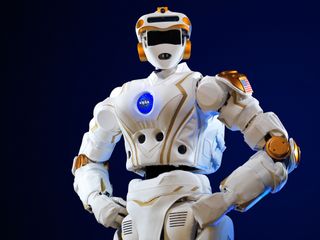Think You Can Guide a Virtual NASA Droid on Mars? You Could Win $1 Million

NASA is offering $1 million to teams that can coax a virtual robot through tricky tasks to save a simulated habitat on Mars.
The robot, based on NASA's Robonaut 5 (R5, also known as Valkyrie), will have to repair the habitat after a dust storm by aligning a communications dish and fixing a solar array and habitat leak, all while dealing with a delay in communication like the real one from Earth to Mars. The contest is a partnership with Space Center Houston and the innovation consultant organization NineSigma.
"Precise and dexterous robotics, able to work with a communications delay, could be used in spaceflight and ground missions to Mars and elsewhere for hazardous and complicated tasks, which will be crucial to support our astronauts," Monsi Roman, program manager of NASA's Centennial Challenges, said in a statement. "NASA and our partners are confident that the public will rise to this challenge, and are excited to see what innovative technologies will be produced."
Robots like R5 could one day explore new territory before humans can, help them on their long interplanetary journeys, conduct preliminary scientific research and take care of habitats once humans leave, officials said in the statement.
Teams can register for the Space Robotics Challenge now, and enter a qualifying round running from mid-September to mid-November. Finalists, announced in December, will be able to do practice rounds up until the final competition, which will be held virtually in June 2017.
The successful software developed during the competition can be used with R5 and also earlier robots, such as Robonaut 2, which was sent to the International Space Station in 2011. The contest is a part of NASA's Centennial Challenges program, which encourages innovation and technological advances for spaceflight through open competitions.
You can read more about the challenge and registration here: https://www.nasa.gov/spacebot/.
Get the Space.com Newsletter
Breaking space news, the latest updates on rocket launches, skywatching events and more!
Email Sarah Lewin at slewin@space.com or follow her @SarahExplains. Follow us @Spacedotcom, Facebook and Google+. Original article on Space.com.
Join our Space Forums to keep talking space on the latest missions, night sky and more! And if you have a news tip, correction or comment, let us know at: community@space.com.

Sarah Lewin started writing for Space.com in June of 2015 as a Staff Writer and became Associate Editor in 2019 . Her work has been featured by Scientific American, IEEE Spectrum, Quanta Magazine, Wired, The Scientist, Science Friday and WGBH's Inside NOVA. Sarah has an MA from NYU's Science, Health and Environmental Reporting Program and an AB in mathematics from Brown University. When not writing, reading or thinking about space, Sarah enjoys musical theatre and mathematical papercraft. She is currently Assistant News Editor at Scientific American. You can follow her on Twitter @SarahExplains.
